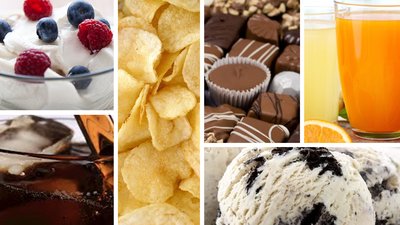Warning! Food companies are taking advantage of your New Year's resolution to get fit. Good marketing can make products seem fat-loss friendly, but most of the time companies are just trying to make money. They don't actually have your best interests at heart.
Don't be fooled! The following foods are only disguised as healthy—the reality is much different. Just like the end of every Scooby Doo episode, find out what happens when we rip off the mask and show you the truth.
1. Fat-Free Yogurt
Many new dieters see the words "fat-free" and crowd the dairy aisle hoping to get their hands on some. Fitting yogurt into your diet depends on your goals, but going for the "fat-free" version may actually hinder your progress.
The problem with fat-free yogurt is that it's not sugar-free. Because the fat has been taken out, the yogurt doesn't taste good. A lot of companies load the yogurt with sugar to make up for the lost flavor.

Furthermore, some of these yogurts are made with thickening agents. These unnatural additives are no good.
2. Diet Soda
Diet soda is calorie-free, so many dieters think it's a go-to beverage when they're in the mood for something sweet. Although there aren't any calories, diet soda is loaded with chemicals that can make you feel bloated, suffer headaches, and may even increase your risk for heart disease and other health problems.

Those who regularly drink diet soda often find that they have stronger cravings for sweet food. If you crave sweet food all day, sticking to your diet is going to be 10 times more difficult.
3. Fat-Free Potato Chips
Who doesn't miss the crunchy salty taste of chips when they diet? Even if you find the craving overwhelming, opting for fat-free chips is not a good call. Fat-free chips are often made with "fat replacers."

Fat replacers are made by adding carbs (maltodextrin, polydextrose, etc.), chemically altered fatty acids (Olestra), or protein to products instead of fat. These replacements have fewer calories but can still make food taste good and have better texture.
Whether fat replacers are bad for you has not been scientifically proven. However, many people complain of digestive distress after eating food made with fat replacers. It's also been shown that because Olestra is not digested or absorbed, it doesn't release Vitamins A, D, or E. It's possible to have deficiencies in these vitamins if you eat Olestra with any sort of consistency.
It is better to ditch chips altogether. They're simple carbs that will only cause a blood-glucose spike and a then lead to a hunger crash.
If you must have chips, thinly slice a sweet potato and bake the slices to make your own.
4. Low-Fat Ice Cream
Low-fat ice cream has similar problems to low-fat yogurt. Sure, there's less fat, but usually that means there's more sugar, sometimes in the form of high-fructose corn syrup.
High-fructose corn syrup is one of the leading causes of obesity. Taking steps to omit that ingredient from your diet, forever, will serve you well.

5. Sugar-Free Chocolate
Sugar-free chocolate seems like guilt-free nutritional nirvana. However, much sugar-free chocolate contain various sugar alcohols. For some people, sugar alcohols can cause digestive issues such as gas, bloating, diarrhea, and/or constipation.

Just because the chocolate is sugar-free, doesn't mean you should scarf an entire bar. It still contains calories and fat. Don't be misled.
6. Fruit Drinks
The famous "made with real fruit" slogan is tricky. Sure there might be some fruit in your juice, but if you read the label, you'll find that you're probably drinking sugar, high-fructose corn syrup, or flavor-enhancing chemical additives.

Fruit drinks are also notoriously high in calories. Drinking them isn't going to do your low-calorie diet any good. They may give you some vitamin C, but the benefits do not outweigh the negatives.
Good Nutrition Practices
Eat the real thing (whole foods!), but eat it in moderation. If you want fruit, don't get juice—eat an apple.
Natural foods are best. If you eat food that's close to its source, you won't have to worry about an influx of harmful chemicals.
The best thing you can do for yourself is to read the ingredient label. If there are one hundred ingredients—many of which you can't pronounce—put it down and run for the produce section!

